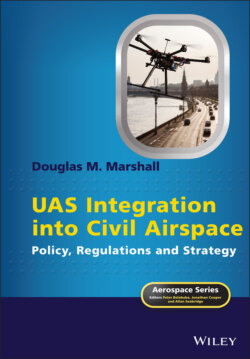Читать книгу UAS Integration into Civil Airspace - Douglas M. Marshall - Страница 7
Organization of the Book
ОглавлениеThe following chapters will introduce the reader to the major issues confronting the developers of these strategies and provide a brief introduction to what each nation or group of nations is doing to address those issues. The templates adopted by the major contributors as they work their way through the often conflicting and sometimes overlapping regulatory environments in which they must operate to be successful are discussed in greater detail. There are many parallel efforts to identify a path to full integration of unmanned systems with manned aviation, and they do not all agree on the strategy or the architecture to make it so. For this reason, this book is unashamedly broad in scope in some respects and rather narrow in others. The goal is to identify a common way forward for the evolving UAS industry and the regulatory authorities that must enable and monitor its growth to ensure public safety and economic viability.
Chapter 1 “Background” introduces a thumbnail history of aviation regulations, derived in some respects from the ancient Law of the Sea. This chapter briefly summarizes the first attempts to regulate airplanes and their pilots in the UK, the creation of an international regulatory body (ICAO) in 1944 as a product of the Chicago Convention on International Civil Aviation, and then moves on to the present-day regulatory system, both national and international, that oversees all aspects of commercial and private aviation.
Chapter 2 “UAS Airspace Integration in the European Union” is a longer chapter, and attempts to cover historical and ongoing regulatory efforts in the European Union regarding unmanned aircraft operations and standards. The EU has been very busy adopting regulations for UAS that will apply across all of its Member States, and more recently embarked upon the concept of a “U-space” that is intended to integrate UAS/RPAS into the European airspace by establishing a new concept for how the airspace can be managed while not disrupting existing commercial and general aviation activities.
Chapter 3 “ICAO” covers the International Civil Aviation Organization and its airspace integration activities with specific focus on remotely piloted aircraft systems.
Chapter 4 “UAS Airspace Integration in the United States” discusses airspace integration efforts in the United States, in coordination with Europe’s EASA and other national aviation authorities.
Chapter 5 “Global Airspace Integration Activities” takes a look at UAS integration efforts in a few selected countries that are considered to be representative of similar efforts in a growing number of ICAO’s 193 Member States.
Chapter 6 “The Role of Standards” examines the role of Standards Development Organizations (SDOs) in the development of regulations and best practices.
Chapter 7 “The Technology” discusses the various domains of the evolving UAS and UTM/U-space technology, and includes suggestions for a methodologies for conducting a risk assessment and functional decomposition of complex systems. Chapter 8 “Cybersecurity and Cyber Resilience” offers a historical view of global cybersecurity failures and ties that history to current efforts to identify risks and defensive mechanism to ensure the security of aviation systems.
This is not an engineering text, nor is it a law book, but is a bit of a hybrid of both, focused on the study of one highly technical sector of innovation and economic growth from the proverbial “30,000 ft” view. The reader is cautioned, however, that the technology advances are extremely dynamic, and innovation, or “the next best thing,” is almost a daily occurrence, so that accurately predicting the future is a fool’s errand. As new challenges emerge, entrepreneurs and developers will step up to meet them, occasionally creating a new technology or new subset of existing technology that may not have existed even a year ago. The best we can do is to understand what is happening at this point in time and acquire the tools to respond to the breakneck pace of innovation in unmanned aircraft systems.
